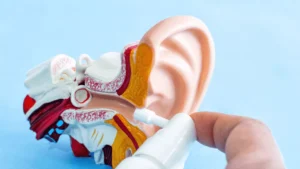Vertigo in Children
Children can have vertigo, despite it being commonly thought of as an adult disorder. It presents as a spinning or dizzy feeling, which can be very upsetting and perplexing for younger patients. It is crucial for parents, carers, and healthcare professionals to comprehend the causes of vertigo in children as well as available treatments. We’ll look at all the different facets of vertigo in kids in this blog post, giving you a thorough rundown.
Understanding Vertigo in Children
What is Vertigo?
Vertigo is not an actual illness; rather, it is a symptom. It features a spinning or moving sensation, and it may be accompanied by vertigo, nausea, problems with balance, and trouble standing or walking. Children who are experiencing vertigo may describe their symptoms as feeling lightheaded, dizzy, or as though the room is moving.
How Common is Vertigo in Children?
Children can experience vertigo, although less frequently than in adults. When it comes to young children, who can have trouble expressing their symptoms, diagnosis can be especially problematic. Vertigo, however, can be properly recognized and treated with close monitoring and a suitable medical evaluation.
Causes of Vertigo in Children
Benign Paroxysmal Vertigo of Childhood (BPVC)
Among the most frequent causes of vertigo in children is BPVC. The condition usually affects preschool-aged children and is typified by abrupt, fleeting episodes of vertigo. Children may look pale, unsteady, or scared during these episodes, and they may feel sick to their stomachs or throw up. BPVC is frequently resolved by adolescence and is widely thought to be a precursor to migraines.
Vestibular Migraines
Another prevalent cause of vertigo in children is vestibular migraines. Vertigo episodes, which are frequently accompanied by headaches, light and sound sensitivity, and nausea, can be brought on by these migraines. Vestibular migraines, in contrast to BPVC, can last into adulthood.
Inner Ear Infections

Image Source: Canva
Children who have labyrinthitis or inner ear infections may have vertigo. Symptoms of this illness, which usually accompany a bacterial or viral infection, include ear pain, dizziness, balance issues, and hearing loss. In order to reduce vertigo symptoms, the underlying infection must be treated quickly.
Meniere’s Disease

Image Source: Canva
Meniere’s disease can induce vertigo episodes, hearing loss, tinnitus, and a fullness in the ear, though these symptoms are uncommon in children. Because it is unpredictable, this chronic inner ear disorder can be especially difficult to manage.
Head Injuries
Children who have head injuries, such as concussions, may have vertigo. Dizziness, problems with balance, and other similar symptoms might be brought on by the trauma’s disruption of the vestibular system. After any head injury, it is imperative to get medical help in order to evaluate and treat any possible sequelae.
Other Causes
Other potential causes of vertigo in children include:
- Medications: Some medications can have side effects that include vertigo or dizziness.
- Dehydration: Severe dehydration can lead to dizziness and balance problems.
- Neurological Disorders: Conditions such as epilepsy or multiple sclerosis, though rare in children, can cause vertigo as a symptom.
Diagnosing Vertigo in Children
Medical History

Image Source: Canva
The next step in identifying vertigo in children is obtaining a comprehensive medical history. The child’s symptoms, the length and frequency of vertigo episodes, possible causes, and any concurrent symptoms like headaches or hearing loss will all be questioned by medical professionals.
Physical Examination
Finding any underlying medical issues that might be the source of vertigo is much easier with a thorough physical examination. An evaluation of the child’s balance, coordination, and eye movements may be part of the examination.
Hearing Tests
Hearing tests are frequently performed to look for inner ear anomalies or hearing loss that may be causing vertigo.
Imaging Studies
Imaging tests, such as CT or MRI scans, may occasionally be required to rule out structural problems in the inner ear or brain.
Specialized Vestibular Tests
Tests with specificity, like the electronystagmography (ENG) or video head impulse test (vHIT), can be used to identify vestibular diseases and evaluate vestibular system function.
Treatment Options for Vertigo in Children
Medications

Image Source: Canva
Prescription medications may be used to treat underlying illnesses or control vertigo symptoms. Typical medications consist of:
- Antihistamines: Help reduce dizziness and nausea.
- Benzodiazepines: Used to manage acute vertigo episodes.
- Migraine Medications: For children with vestibular migraines, medications like triptans or beta-blockers can be effective.
Vestibular Rehabilitation Therapy (VRT)
With vestibular retraining therapy (VRT), exercises are used to enhance balance and lessen vertigo by teaching the brain to process vestibular system signals more efficiently. Children with persistent vertigo may benefit most from this kind of therapy.
Lifestyle and Dietary Changes
Certain dietary and lifestyle adjustments can assist children with vestibular migraines or Meniere’s disease control their symptoms. These could consist of:
- Hydration: Ensuring the child drinks plenty of fluids.
- Dietary Adjustments: Reducing salt, caffeine, and sugar intake.
- Regular Sleep Patterns: Maintaining consistent sleep schedules to reduce the risk of migraines.
Surgery

Surgical interventions might be required in very uncommon circumstances. When all other therapies have been exhausted and the child’s quality of life is severely compromised by vertigo, surgical options are usually taken into consideration.
Managing Triggers
Reducing the frequency and intensity of vertigo episodes can be achieved by identifying and treating causes. A few common factors are stress, sleep deprivation, certain meals, and dehydration.
Supporting Children with Vertigo
Educating Parents and Caregivers
It is essential to teach parents and other carers about vertigo and how to handle it. Comprehending the health condition enables them to offer enhanced assistance and discern whether to pursue medical intervention.
School Accommodations
In order to control their symptoms, children with vertigo may require modifications at school. This can involve giving assignments more time, finding a quiet place to rest when experiencing vertigo, and avoiding activities that could make you feel lightheaded.
Psychological Support
For kids, vertigo can be upsetting and negatively affect their well-being and mental health. Offering psychological support, such as therapy or counseling, can assist kids in managing their vertigo symptoms and lowering anxiety associated with them.
Conclusion
Although less common than in adults, vertigo in children still needs to be carefully monitored and treated. Accurate diagnosis and therapy depend on an understanding of the various causes, which include head traumas, vestibular migraines, inner ear infections, and BPVC. The diagnosis process has been enhanced by developments in vestibular testing, physical examinations, hearing tests, and medical history assessment.
Children with vertigo may be able to manage and lessen their symptoms with the use of treatment options such as medication, vestibular rehabilitation therapy, lifestyle modifications, and in certain situations, surgery. The quality of life for children suffering by vertigo can be greatly enhanced by educating parents, carers, and schools about the condition and offering psychological support.
Healthcare professionals, as well as families, may guarantee that children with vertigo receive the best care possible, enabling them to lead healthy, active lives, by keeping up to date on the most recent research and developments in the treatment of vertigo.
FAQ’s
What is vertigo in children?
– Vertigo in children is a sensation of feeling off balance or spinning, which can be caused by various factors such as ear infections, migraines, and other underlying conditions.
What are the common causes of vertigo in children?
– Common causes of vertigo in children include ear infections, respiratory allergies, and migraines. Other factors such as head traumas, inner ear infections, and psychiatric disorders can also contribute to vertigo in children.
What are the symptoms of vertigo in children?
– Symptoms of vertigo in children include dizziness, paleness, headache, visual disturbance, fear in young children, migraine, hearing loss or ringing in the ears, nausea, and clumsiness or loss of balance.
How is vertigo diagnosed in children?
– Vertigo in children is typically diagnosed through a combination of medical history, physical exams, and diagnostic tests such as vestibular function tests, imaging studies, and blood tests. A pediatric otolaryngologist (ENT specialist) is usually the most qualified professional to conduct a comprehensive evaluation.
What are the treatment options for vertigo in children?
– Treatment options for vertigo in children include medications, physical therapy, and lifestyle changes. The goal of treatment is to alleviate symptoms and identify and address the underlying cause of the vertigo.
Can vertigo in children be cured?
– While some cases of vertigo in children can be cured, others may require ongoing management. The effectiveness of treatment depends on the underlying cause of the vertigo and the individual child’s response to therapy.
How can I manage my child’s vertigo symptoms?
– Managing vertigo symptoms in children involves a combination of lifestyle changes, medications, and physical therapy. This may include avoiding triggers such as sudden movements or changes in position, taking medications as prescribed, and engaging in physical therapy exercises to improve balance and reduce vertigo symptoms.
Can stress cause vertigo in children?
– Stress can worsen vertigo symptoms in children, but it is not a direct cause of vertigo. Other factors such as ear infections, migraines, and head traumas can contribute to the development of vertigo in children.
How can I prevent vertigo in children?
– Preventing vertigo in children involves maintaining good ear hygiene, avoiding sudden movements or changes in position, and managing stress. It also involves taking medications as prescribed and engaging in physical therapy exercises to improve balance and reduce vertigo symptoms.
Can vertigo in children be treated with physical therapy?
– Yes, vertigo in children can be treated with physical therapy. Vestibular rehabilitation therapy (VRT) is a specialized form of physical therapy that can help improve balance and reduce vertigo symptoms in children.
